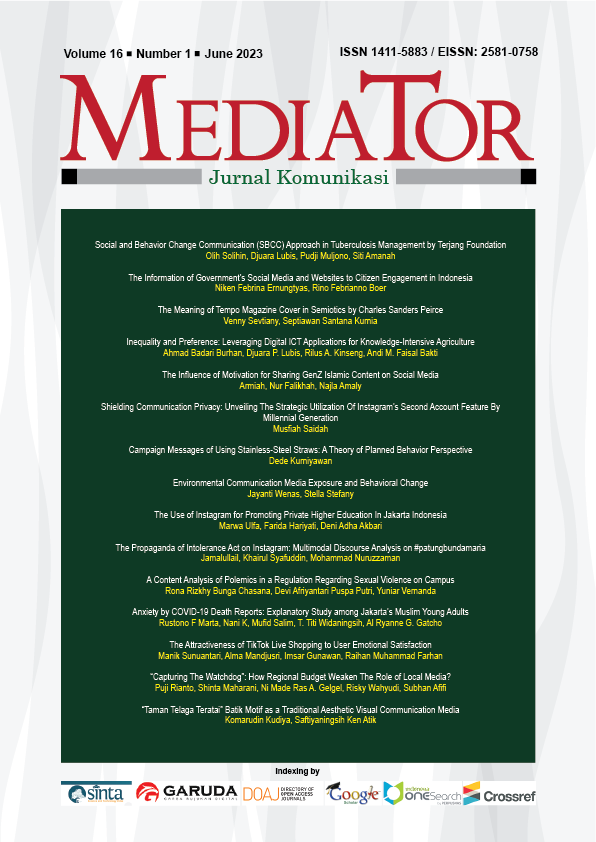The Information of Government’s Social Media and Websites to Citizen Engagement in Indonesia
DOI:
https://doi.org/10.29313/mediator.v16i1.2159Keywords:
social media, government websites, transparency, citizen trust, citizen engagementAbstract
Social media and government websites can become communication tools to encourage participation and interaction between citizens and government institutions. Digital media may lead to citizens’ trust and citizen engagement toward the government. The purpose of this study is to examine the model of attention to social media, attention to official government websites, perceptions of transparency, public trust, and civic engagement in the Indonesian context. This study used a quantitative survey approach (N = 263). Structural Equation Modeling – Partial Least Square (SEM) is used to assess four hypotheses. This study reveals that Attention to Social Media and Attention to Government Websites moderately explain the influence on Perceived Transparency. Moreover, perceived transparency significantly and strongly influences citizens’ trust and Citizen Engagement is quite stronger explained by the Citizen Trust. This study reveals that the information exposure on the government website and social media leads to citizen engagement mediated by the perceived transparency and citizens’ trust.
References
Adiputra, I. M. P., Utama, S., & Rossieta, H. (2018). Transparency of local government in Indonesia. Asian Journal of Accounting Research, 3(1), 123–138. https://doi.org/10.1108/ AJAR-07-2018-0019
Akbar, P., Nurmandi, A., Irawan, B., Qodir, Z., & Juba, H. (2022). Public Trust on Policy for Mobility Restrictions Policy in Indonesia an Analysis from Social Media Twitter. Communications in Computer and Information Science, 1582 CCIS, 340–348. https://doi. org/10.1007/978-3-031-06391-6_44
Al-Aufi, A. S., Al-Harthi, I., AlHinai, Y., Al-Salti, Z., & Al-Badi, A. (2017). Citizens’ perceptions of government’s participatory use of social media. Transforming Government: People, Process and Policy, 11(2), 174–194. https://doi.org/10.1108/TG-09-2016- 0056
Christensen, T., & Laegreid, P. (2005). Trust in Government: The Relative Importance of Service Satisfaction, Political Factors, and Demography. Public Performance & Management Review, 28(4), 487–511.
Edelman. (2021). Edelman Trust Barometer 2021. https://www.edelman.com/ sites/g/files/aatuss191/files/2021- 01/2021-edelman-trust-barometer.pdf
Grimmelikhuijsen, S., & Klijn, A. (2015). The effects of judicial transparency on public trust: Evidence from a field experiment. Public Administration, 93(4), 995–1011. https://doi. org/10.1111/padm.12149
Handoko, M. R., & Stellarosa, Y. (2020). The Influence of President Joko Widodo’s Instagram Content on Beginner Voters Participation in the 2019 General Elections. Mediator: Jurnal Komunikasi, 13(1). https://doi. org/10.29313/mediator.v13i1.5161
Hernawati, R., Palapah, M. A. O., & Noviar, T. N. A. (2022). Communication Strategy of Private University’s PR Practitioners To Attract Students’ Interest In Time Of Covid-19 Pandemic. Mediator: Jurnal Komunikasi, 15(1), 78–90.
Howard, P. N., Savage, S., Flores Saviaga, C., Toxtli, C., & Monroy-Hernández, A. (2016). Social Media, Civic Engagement, and the Slacktivism Hypothesis. Journal of International Affairs, 70(1), 55–73. https://doi. org/10.2307/90012597
Idris, I. K. (2018). Government social media in Indonesia: Just another information dissemination tool. Jurnal Komunikasi: Malaysian Journal of Communication, 34(4), 337–356. https://doi. org/10.17576/JKMJC-2018-3404-20
Irwansyah, I., Rusfian, E. Z., & Ernungtyas, N. F. (2016). Credibility of Health Site Based on Design and Information Content. MIMBAR, 32(1), 107–115.
Kushin, M. J., & Yamamoto, M. (2010). Did social media really matter? college students’ use of online media and political decision making in the 2008 election. Mass Communication and Society, 13(5), 608–630. https://doi.or g/10.1080/15205436.2010.516863
Lee, Y., & Li, J. Y. Q. (2021). The role of communication transparency and organizational trust in publics’ perceptions, attitudes and social distancing behaviour: A case study of the COVID-19 outbreak. Journal of Contingencies and Crisis Management, 29(4), 368–384. https:// doi.org/10.1111/1468-5973.12354
Lee, J., Kim, H. J., & Ahn, M. J. (2011). The willingness of e-Government service adoption by business users: The role of offline service quality and trust in technology. Government Information Quarterly, 28(2), 222–230. https://doi. org/10.1016/j.giq.2010.07.007
Lembaga Survei Indonesia. (2021, September 21). Rilis Survei LSI terkait Vaksin 18 Juli 2021. Lsi.or.Id. https://www. lsi.or.id/post/rilis-survei-lsi-terkait-vaksin-18-juli-2021
Leonard, A. B. (2020, April 2). Pentingnya Inovasi Kepemimpinan dan Civic Engagement di Daerah dalam Menghadapi COVID-19. CSIS Commentaries, 1–5. https://www. csis.or.id/publications/pentingnya-inovasi-kepemimpinan-dan-civic-engagement-di-daerah-dalam-menghadapi-covid-19/
Loader, B. D., Vromen, A., & Xenos, M. A. (2014). The networked young citizen: social media, political participation and civic engagement. In Information Communication and Society (Vol. 17, Issue 2, pp. 143–150). https://doi.org/1 0.1080/1369118X.2013.871571
Meijer, A. J., Curtin, D., & Hillebrandt, M. (2012). Open government: Connecting vision and voice. International Review of Administrative Sciences, 78(1), 10–29. https://doi. org/10.1177/0020852311429533
Neuman, W. L. (2014). Social Research Methods: Qualitative and Quantitative Approaches. In Pearson Education Limited (Vol. 7). https://doi. org/10.2307/3211488
Perangin-angin, L. L. K., & Zainal, M. (2018). Partisipasi Politik Pemilih Pemula Dalam Bingkai Jejaring Sosial Di Media Sosial. Jurnal ASPIKOM, 3(4), 737. https://doi.org/10.24329/ aspikom.v3i4.210
Rusfian, E. Z., Irwansyah, & Ernungtyas, N. F. (2017a). Visual aesthetics and websites credibility of Indonesia stock exchange. Advanced Science Letters, 23(8). https://doi.org/10.1166/ asl.2017.9612
Rusfian, E. Z., Irwansyah, I., & Ernungtyas, N. F. (2017b). Usabilitas, Desain dan Informasi Konten Situs Bursa Efek Indonesia. Jurnal ASPIKOM, 3(3), 476–493.
Salman, A., Yusoff, M. A., Salleh, M. A. M., & Abdullah, M. Y. H. (2018). Penggunaan Media Sosial untuk Sokongan Politik di Malaysia. Journal of Nusantara Studies (JONUS), 3(1), 51–63.
Santoso, A. D., Rinjany, D. K., & Bafadhal, O. M. (2020). Social Media and Local Government in Indonesia: Adoption, Use and Stakeholder Engagement. Romanian Journal of Communication and Public Relations, 22(3), 21–35.
Song, C., & Lee, J. (2016). Citizens Use of Social Media in Government, Perceived Transparency, and Trust in Government. Public Performance and Management Review, 39(2), 430–453. https://doi.org/10.1080/15309576.201 5.1108798
Uslaner, E. M., & Brown, M. (2005). Inequality, trust, and civic engagement. In American Politics Research (Vol. 33, Issue 6, pp. 868–894). https://doi. org/10.1177/1532673X04271903
Warren, A. M., Sulaiman, A., & Jaafar, N. I. (2014). Social media effects on fostering online civic engagement and building citizen trust and trust in institutions. Government Information Quarterly, 31(2), 291–301. https://doi. org/10.1016/j.giq.2013.11.007
Wibowo, K. A., & Mirawati, I. (2013). Realitas Politik Indonesia Dalam “Kacamata” Pengguna Twitter. Jurnal Kajian Komunikasi, 1(1), 11–17. https://doi.org/10.24198/jkk.vol1n1.2
Wiguna, A., & Nuraeni, R. (2021). Management Of Alternative Media Kawalcovid19 as A Source of Information During The Covid-19 Pandemic. Mediator: Jurnal Komunikasi, 14(2), 229–239. https:// doi.org/10.29313/mediator.v14i2.8415
Wong, K. K.-K. (2013). Partial Least Squares Structural Equation Modeling (PLS-SEM) Techniques Using SmartPLS. Marketing Bulletin, 24. http:// marketing-bulletin.massey.ac.nz
Ye, Y., Xu, P., & Zhang, M. (2017). Social media, public discourse and civic engagement in modern China. Telematics and Informatics, 34(3), 705–714. https://doi.org/10.1016/j. tele.2016.05.021
Downloads
Published
Issue
Section
License
Copyright (c) 2023 Author

This work is licensed under a Creative Commons Attribution-ShareAlike 4.0 International License.























